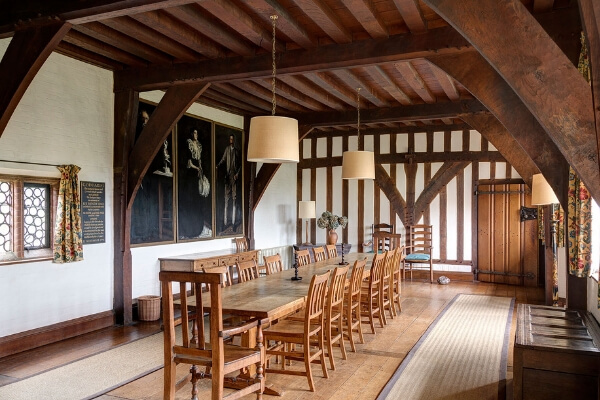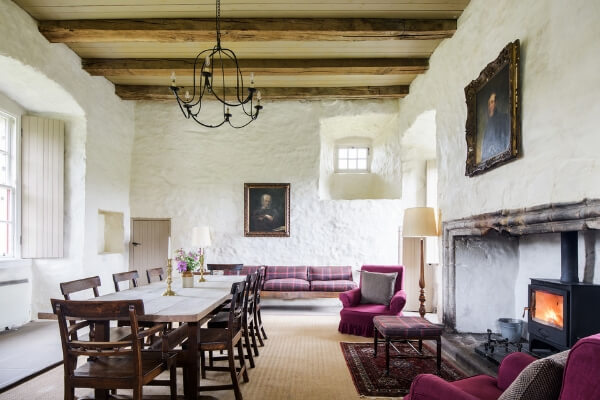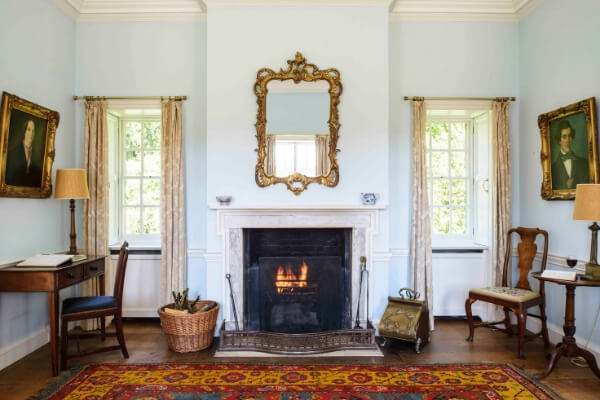 The dining room in Goddards, Surrey
The dining room in Goddards, Surrey
For nearly 40 years this aspect of the organisation’s work has been overseen by John Evetts who advises Landmark on furnishing and interiors from his base at Honeybourne in Worcestershire.
From the early days, the Landmark Trust’s interiors were designed in-house, with a view to making them both welcoming and in harmony with the building. ‘I try to make them into somewhere where you can be comfortable and at ease’ says John, ‘but it shouldn’t feel ‘designer’ done; I don’t want people to feel they have to tiptoe around it, or that the decoration jars with the age of the building.’
The furniture used in Landmark’s buildings is generally a mixture of carefully chosen – but rarely valuable – old pieces and new items we have either selected as appropriate, or created ourselves. The sofas and chairs are large and comfortable, and the beds all have high-quality modern mattresses specially made for Landmark.
 The living room in Castle of Park, Dumfries and Galloway
The living room in Castle of Park, Dumfries and Galloway
The kitchens are usually hand-made in the Honeybourne workshop, essential as one of Landmark’s challenges has been to incorporate modern kitchens sensitively into historic spaces. At Clytha Castle, a sham-castle in Monmouthshire, the cupboards in the kitchen curve with the walls of a circular room; at Queen Anne’s Summerhouse, they open outwards with the doors of a large closet, while at Beckford’s Tower, the kitchen is subtly incorporated in the vestibule to William Beckford’s Scarlet Drawing Room.
Other specialist elements made in our workshops have included the bookcases for Pugin’s Library at the Grange in Ramsgate. This project to restore the great architect’s house was an ambitious one even for Landmark. ‘It nearly killed me’ says John, ‘but it was the most rewarding job we’ve ever done. Everyone who worked on it says, ‘when can we do another Grange?’
The Landmark interiors are designed to both elegant and simple. The pictures, the printed textiles – long the particular responsibility of Lady Smith – the furniture and the decorative details are chosen to bring out the character of the building. But the hope is that they should never be pompous. The decoration, like many of the buildings themselves, has a playfulness. ‘I always try to put something in every building which introduces a little humour’, says John remembering his mentor Sonia Rolt’s delight in hanging melodramatic wreck pictures in all the buildings on Lundy.
 The Chateau, Lincolnshire
The Chateau, Lincolnshire
At Kingswear Castle a flag lies out of sight in a drawer for enterprising visitor to hoist on the castle’s flagpole, while visitors to Lutyens’ Goddards find the skittle alley, equipped with its heavy wooden balls and nine pins, ready for the deafening game to be played.
‘I’ve spent my life doing something that has given an enormous amount of pleasure, that’s tremendously fulfilling and I know it sounds odd still to be putting sofas and chairs in buildings nearly forty years on, but I find that when it looks good, it’s as satisfying as the first time I did it.’